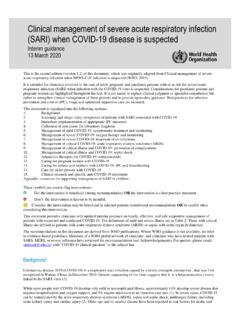Transcription of スポーツ 頭部外傷 における sports-related head injuries 脳神 …
1 1,11 2,11 3,11 4,11 4,11 5,11 6,11 7,11 8,11 2,11 9 10 41 2 3 4 5 6 7 8 9 10 11 Key words:Sport head injuryConcussionAcute subdural hematomaReturn to playGuidelineReceivedJuly 9, 2013 AcceptedJuly 16, 2013 Neurotraumatology 36: 119 128, 2013 Neurosurgical management ofsports-related head injuries Interim consensus statement for guideline development SHINJINAGAHIRO1,11, SATOSHITANI2,11, MASAHIROOGINO3,11,TATSUROKAWAMATA4,11, TAKESHIMAEDA4,11,MASATONOJI5,11, TADASHINARIAI6,11, HARUONAKAYAMA7,11,OSAMAUFUKUDA8,11, TOSHIAKIABE2,11, MICHIYASUSUZUKI9,KAZUOYAMADA10, YOICHIKATAYAMA4 Department of Neurosurgery,1 Tokushima University2 Jikei University School of Medicine3 Dokkyo Medical University4 Nihon University5 Kanagawa Prefectural Ashigarakami Hospital6 Tokyo Medical and Dental University7 Toho University Medical Center Ohashi Hospital8 Saitoh Memorial Hospital9 Yamaguchi University10 Nagoya City University11 Committee of Sports Head injuries ,The Japan Society of NeurotraumatologyJudo-related severe head injury in children and adolescentsis a hot topic in the media and in society.
2 Neurosurgeons areoften involved in many other sports-related head Committee of Sport Head Injury in the Japan Society ofNeurotraumatology has studied to develop guideline forneuro surgeons how to manage the athletes with sports-related concussion or an intracranial structural lesion, andhow to allow them to return to concussion includes not only transientuncon sciousness and amnesia but also various somatic ( ache), cognitive and emotional symptoms. The mostcon cussions typically resolve in a short time, although therecovery may be longer over a week in children and adoles-cents. The Sports Concussion Assessment Tool (SCAT) is thestandard method for evaluation of concussion. Repeatedcon cussions may produce rapid catastrophic deterioration(sec ond impact syndrome) or chronic traumatic encephalo -pathy presenting with cognitive dysfunction.
3 Second impactsyn drome may occur in association with acute subduralhematoma. In concussion patients with prolonged symp-toms ( headache ), brain CT or MRI should be recom-mended to exclude an intracranial structural lesion such asthin subdural hematoma. Once concussion is diagnosed, anathlete should not be return to play in the same day. Anathlete must be asymptomatic prior to return to play, andshould take a graduated return to play protocol lastingaround one week. Once an intracranial structural lesion ( hematoma) has been found after sport head injury,the athlete should not be allowed principally to return to playcontact 36 2013 119 128 Official Journal of The Japan Society of Neurotraumatology120I 24 II
4 1 1- 1964 CNS Congress of neurologicalsurgeons 37 1990 Colorado medical society 17,36,38 2000 Internationalconference on concussion in sport 28,29 Table1 Table1 Symptoms in concussionA concussion should be suspected if any one or more of thefollowing symptoms are 2. 3. 4. 121 1 1- 19 Table2 7 10 5,28,35 20 3 27 1 5,19,20,28 3 13.
5 39 3 19 43 1- 27,28,29,30 2012 4 +html 2008 34 SCAT SportsConcussion Assessment Tool SCAT 3 5 12 Child-SCAT3 SCAT 2 Table2 Post-concussion symptoms1. 2. 3. 4. 5. 6. 7. 8. 9. 10. SCAT SportsConcussionAssessmentTool 122 SCAT 3 Pocket CRT CONCUS-SION RECOGNITION TOOL Pocket SCAT 2 2 version of Pocket SCAT 2- 1973 Schneider 42 1984 Saunders 40 1 0 30 1 2 2 2 Cantu vasoparalysis 1 30 50 18 1
6 2- 2 2,31 2 Cantu 26 Cantu vasoparalysis 2 1 2- chronic traumat-ic encephalopathy post-traumatic encephalopa-thy 16 punch-drunk syndrome, boxer's encephalopathy 1928 Martland 24 Retrospective 17 50 CT MRI Purkinje 2 124 44 3 3.
7 CT 5 11,22 4,31,32,40 2 CT MRI 16,24 MRI 12,14 18 3- CT MRI CT 45 23 CT CT MRI , man presented with persisting severeheadache after a match of (the upper) and MRI FLAIR weighted images (thelower) reveals thin subdural hematoma around the bridgingvein (arrows).
8 125 MRI T1, T2 FLAIR T2* axial 4 4- physical and cognitive rest 25,28 46 28 21 2 3 48 3 5 3 8,9 33 15 2 4 4- 23-year-old man visited the outpatient clinic with persisting headache after amatch of American scans (the upper) and MR FLAIR images (the lower) show the thin subdural hematomaon the temporal convexity (white arrow) and on the tentorium (black arrow) on the rightside.
9 126 28,29 24 medical clearance 28,29 1 6 1 2 3 4 5 6 Table3 28,29,34 24 4 19 10,46 4- 3 33 41
10 33,47 Graduated return to play protocol (modifica-tion of the literatures28,29,34))1. 2. 3. 4. 5. 6. 127 5 6,7 III 36 IV




